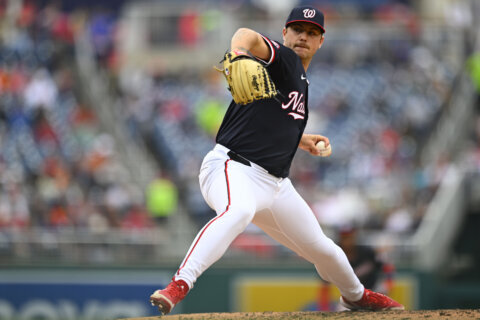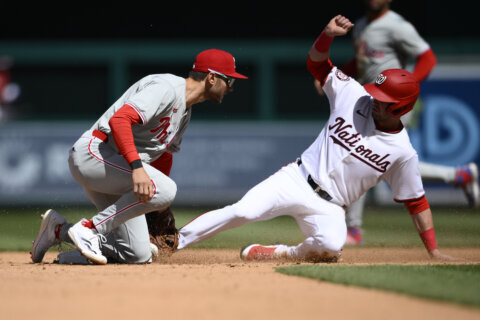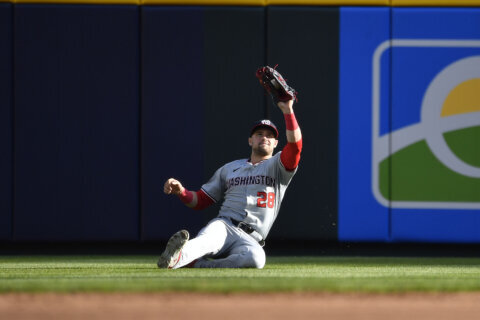By Rich Johnson, WTOP News
WASHINGTON — Even when I was a sports reporter, NASCAR (and auto racing in general) was never high on my radar. Beyond the ‘xxx won Sunday’s race in xxx,’ I knew nothing. That changed over the past decade, starting with a trip to Richmond a decade ago in the wake of unimaginable tragedy. Race organizers added a tribute to the 2006 spring race, which happened just a couple weeks after the mass shooting at Virginia Tech.
Visiting Richmond International Raceway, I was intrigued by the venue, the machines and the culture surrounding the weekly traveling spectacle that is the NASCAR Sprint Cup. Over the next year, I tuned into the Fox TV coverage (while working for Fox News Radio — ever the loyal employee). Fox being Fox, the coverage went far beyond the old mile-long camera pans that were the backbone of network race coverage “BF” (Before Fox).
The death of Dale Earnhardt Sr. in 2001 also helped, in a backhanded way. I was never interested in watching a sport in which it was a good bet that someone might die at any moment. Earnhardt’s death led to a long list of safety improvements in the cars and the tracks, upgrades that have literally saved lives in the 15 years since the sport’s biggest star lost his.
And, being a semi-reluctant fan, I stubbornly decided that I would root for an outlaw — a driver that was loathed by the vast majority of racing fans. That driver exceeded my “villain” expectations for most of the past decade, until he became the sport’s champion last year. Kyle Busch (like his brother Kurt) was, for the longest time, everything the typical NASCAR fan hated: short-fused, brash, young, disrespectful and (what galled fans the most) one hell of a driver. That’s my guy!
Being a radio guy for my entire life, I also came to love the radio side of NASCAR. Long before CBS first broadcast the Daytona 500 from flag to flag in 1979, the Motor Racing Network did every race (later joined by PRN) for a network of mostly southern stations. These days, every race in the three national series — Camping World Truck Series, Xfinity Series and Sprint Cup — is on Sirius/XM Radio’s NASCAR channel. Listening to the announcers in the stands, the turns and in the pits seamlessly go from voice to voice to voice when they’re sometimes literally a mile from each other is one of the great feats of modern radio.
And then there are the race teams. Yes, “team” is very much a part of it. It takes a huge amount of people to build and maintain a race car, and set it up for each weekend. It takes countless hours of practice for six guys to change four tires, make chassis adjustments and fill the tank with gas in about 13 seconds. It takes an experienced spotter high above the track to fill the driver’s blind spot, telling him when it’s safe to move inside or outside. And it takes a crew chief to make the calls on all those adjustments, the timing of pit stops, and keep the driver from going insane inside a 130-degree oven moving anywhere from 90 to 200 mph.
Since I fell under NASCAR’s spell, I’ve seen races at 10 different tracks. And yes, they are different. The shortest tracks are barely a half-mile around. The longest is just over 2 1/2 miles. A couple have flat corners. Daytona, Talladega and Dover’s corners rise nearly three stories at about 30 degrees. Some have concrete surfaces, others asphalt. A race early in the season at one track can be very different when the tour returns to that track later in the season when it’s hotter, colder, or at night instead of during the day. And yes, NASCAR does make right turns — twice a year, at road courses in California and New York.
If you’ve never been to a NASCAR race, here’s some rookie advice: head down I-95 to Richmond or over the Bay Bridge to Dover. Richmond’s high banked, 3/4 mile track is the home of fast racing and close action. If you’re really adventurous, you can walk the sidewalk around the entire track during the race! But if you don’t wear glasses, bring some. Those cars kick up a bits of dirt and debris.
Dover’s ‘Monster Mile’ features banking on a par with the big super speedways — a lap there takes only a couple of seconds longer than a lap at the much shorter Richmond track. But on both tracks, driver ability is just as important as the car’s power. There’s more “car” than “track” — in other words, the cars have more power than it takes to turn through the corners. So it’s on the driver to go as fast as possible without losing control. As the saying goes: If you’re not wrecking, you’re not racing.
Unlike open wheel racing, contact is allowed, and sometimes encouraged. Drivers routinely bump, block and jam each other — what’s known as “trading paint.”
Also consider this: at Richmond, Dover and other NASCAR tracks 1 1/2 miles or shorter, you can see the entire race! That’s impossible in most road-racing formats like Formula 1 and Indy Car. When buying your seats, remember: higher is better. Also: be sure to bring ear protection! It’s beyond loud, even at the top of the stands. The best thing to do is to rent a pair of over-ear headphones and a scanner. You can tune in to a driver’s two-way channel. The unvarnished, uncensored conversations between drivers, spotters and crew chiefs can be quite entertaining. And, if you’re not sure what’s going on, the radio broadcast is vital.
So get to a race this season! And bring plenty of money for the tickets, some t-shirts, die-cast car models, hot dogs, fried baloney sandwiches and (at Dover) crab cakes. It’s a long day trip, but worth it.







